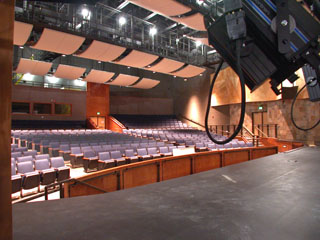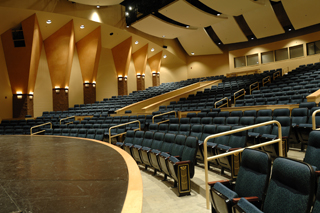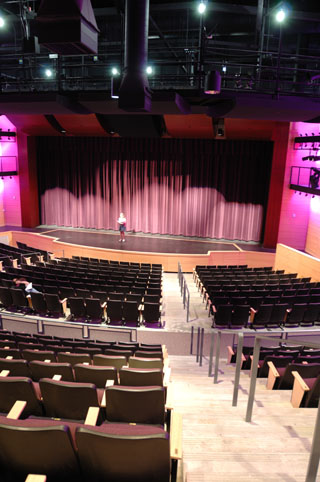
DJC.COM
August 20, 2009
7 things you need to know to build a better stage
PLA Designs

Luntsford
|
When designing a “high school performing arts space,” it is important to really understand what those five words mean. The best way to come to an understanding requires asking three questions:
• What are the core guidelines that inform the shape, footprint and spatial arrangement of the spaces that make up a performing arts wing?
• What are the typical pitfalls that ensnare design professionals during pre-bond and programming efforts?
• What do you need to know to avoid those pitfalls, survive the later meetings with the user groups and remain respectful of the budget?
Unfortunately, much of what is found in professional literature may be outdated. And using outdated models can lead to a problematic design.

Photos courtesy of PLA Designs The shape is based on the sightlines, seat count, width of the stage and the floor-to-floor relationships. This theater is in Lakeridge High School in Lake Oswego, Ore.
|
So, what do we need to ask ourselves and others? What do we need to know?
• Is the client asking for a concert hall? A lecture hall? Will it include a traditional proscenium-style stage or perhaps a thrust stage? Maybe it should be theater in the round? Or...?
• The educational focus of the school district (and local community groups) is critical for informing the design program. The designer must also realize the playbook has changed. Even a five-year-old design could be outdated because of recent code changes.
• The designer must understand throughout the process that this will be a teaching space first and a performance space second.
Let’s try to boil this down to some useful guidelines. There are seven issues which, when resolved early, are instrumental in achieving a successful outcome.
The house

Oregon City High School has both a main stage theater, shown here, and a black-box theater — a type of space that can be used as a drama classroom as well as a secondary performance venue.
|
The house form is based on a combination of sightlines, seat count, width of the stage and floor-to-floor relationships.
Seating should equal one class size (freshmen, sophomores, and so on) and total gross square footage of the house should be equal to 10 square feet per seat. While the actual net amount per seat is only 6 square feet, the additional 4 square feet per seat allows for aisles and internal circulation. This is not the same thing as total building gross up, but we’ll get to that in the next section.
The instrumental music program will most likely dictate the size of the proscenium arch opening to the house, establishing acceptable sightlines. Every seat must be able to see 66 percent of the stage width at the back line of the stage, which is 8 feet in front of the rear wall of the stage.
Concave curved walls will result in problematic performance acoustics and should be avoided. If the surrounding space has 15-foot floor-to-floor dimensions, it will be very difficult to develop a second-floor entry to a house with less than 600 seats.
Gross up
Gross up is the extra square footage that is needed when designing a building to account for mechanical chases, vertical circulation, electrical rooms, storage, and so on.
Despite gross-up margins of 20 percent to 25 percent in the rest of the school, a typical high school theater needs a gross up of 40 percent to 50 percent for things such as vestibules, mechanical chases, pocketed doors, and concealed vertical and horizontal circulation for technicians. Minimum wing space total must be equal to the arch opening width plus 10 feet extra on the rigging side.

Green design methods are difficult to carry out in a performance space. Windows aren’t practical, fluorescent lighting is discouraged and displacement ventilation must be done carefully.
|
For example, a 40-foot-wide arch opening means a 20-foot wing on one side of the arch and a 30-foot wing on the rigging side of the arch. The total stage inside, then, is not less than 90 feet wide.
The minimum support zone area (which includes backstage areas such dressing, makeup, green room, costuming and scene shop) should be not less than the area of the stage and wing area. Significant storage area for props, costumes, scenery, furniture, lighting equipment and raw materials must be provided.
Adjacencies
Effective relationships from adjacent spaces are critical. Care should be taken to ensure movement of bands, choirs, scenery, technicians and patrons takes place in a safe and secure manner. Patrons and actors should be able to move without mixing paths.
Technicians must often move from backstage to the control booth, or around catwalks during performances. Therefore, safe circulation paths should be planned to accommodate unseen movement. Some school districts desire black-box spaces that not only serve as a drama classroom but a secondary performance space.
The scene shop should be at least 150 percent of the standard floor-to-floor height, with ample storage and a 14-foot-high (or taller) roll-up door wide enough for a car to drive through.
A matching door should be placed on the non-rigging side of the stage. Clear floor space long enough to rip a sheet of plywood (26 feet, minimum) should also be provided.
Fly loft height
While a full fly stage with a walk-on grid and roof deck at 65 feet is ideal, the costs associated with such a space make it prohibitive for most school districts.
It is possible to design a theater with a fly loft roof deck at 50 feet and still provide excellent performances and teaching opportunities at a much lower cost.
Though there is the temptation to believe that a stage with a fly loft roof deck at 36 feet would save even more money, it isn’t true. A short loft proscenium stage is false economy and will result in a subpar teaching and performance space for the life of the building.
Orchestra pit
While it is optimal to design a full-depth orchestra pit into the space, this can be cost prohibitive.
It must be stressed that providing no dedicated area for musicians during a “musical” performance renders the first five to 10 rows of the auditorium visually blocked. A simple depression in front of the stage apron as little as 30 inches deep can make or break the auditorium.
Even so, nothing beats a full-depth pit if musical theater will be a regular event in the space.
Accessibility
There are strict guidelines defining accessible seating areas and other accommodations.
For instance, if the design includes a direct route to the stage from the house, there must be equivalent direct access for a wheelchair. Rules such as this make careful consideration of the cost implications of installing mechanical lifts versus providing adequate square footage for ramps, not to mention the consequences to the overall feel of the space with the ramps added.
Furthermore, assembly spaces are defined predominantly by special sections and exceptions in the codes, and vary state by state. Be aware of the special sections and exceptions.
Sustainability
Most of the methods for sustainable or green building design are nearly impossible to implement or very expensive in a performance space. Windows are not practical in a theater space, fluorescent lighting is not a good total house lighting solution, and displacement ventilation must be done very carefully, and only in the house.
However, this does not mean that a theater building cannot employ some sustainable features. The use of T5 high-output lamps in work-lighting fixtures saves energy, and today’s technology enables computerized lighting systems to control power consumption.
It is crucial that design professionals consider these points from the earliest stage of planning, thereby creating performing arts spaces that can act as hands-on laboratories for the practical exploration of history, mathematics, physics, literature and communication through the medium of art. This can be achieved, and within normal project budgets.
Paul Luntsford is the president and principal consultant of PLA Designs, an assembly space consulting firm in Aloha, Ore.
Other Stories:
- My epiphany on learning: It’s the method, not the content
- South Shore campus will create a hub for the community
- Medina school celebrates cycles of nature, learning
- Architects add a new role to their job duties: facilitator
- Attention to detail makes WWU building unique
- Bouncing sounds make lecture halls tricky to design
- Robert Frost Elementary design takes road less traveled
Copyright ©2009 Seattle Daily Journal and DJC.COM.
Comments? Questions? Contact us.